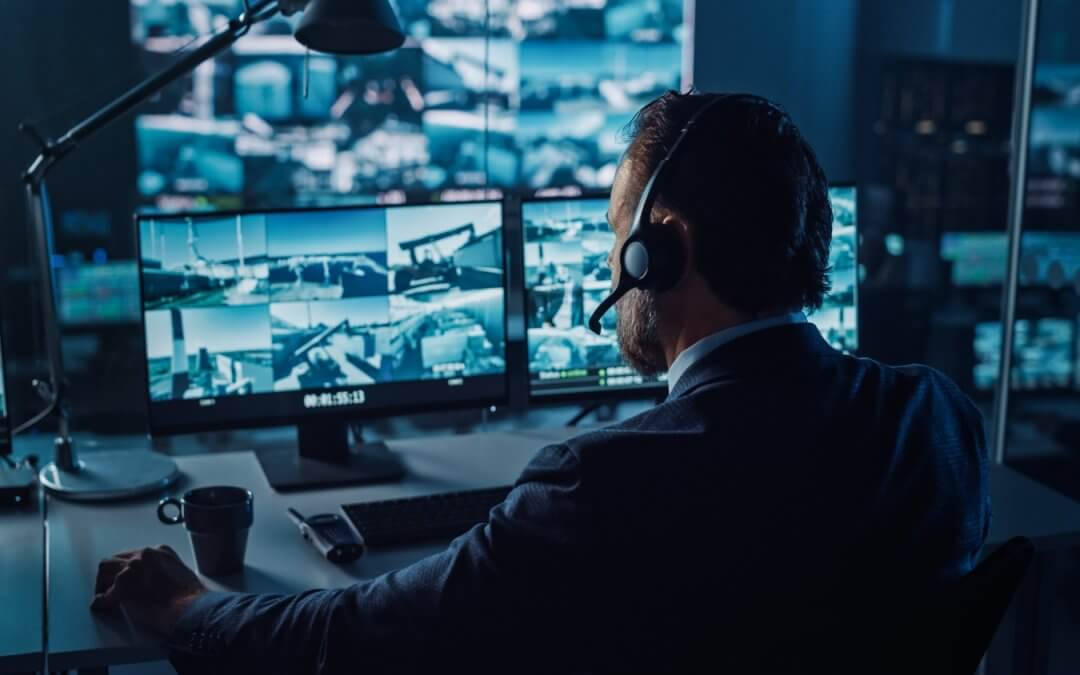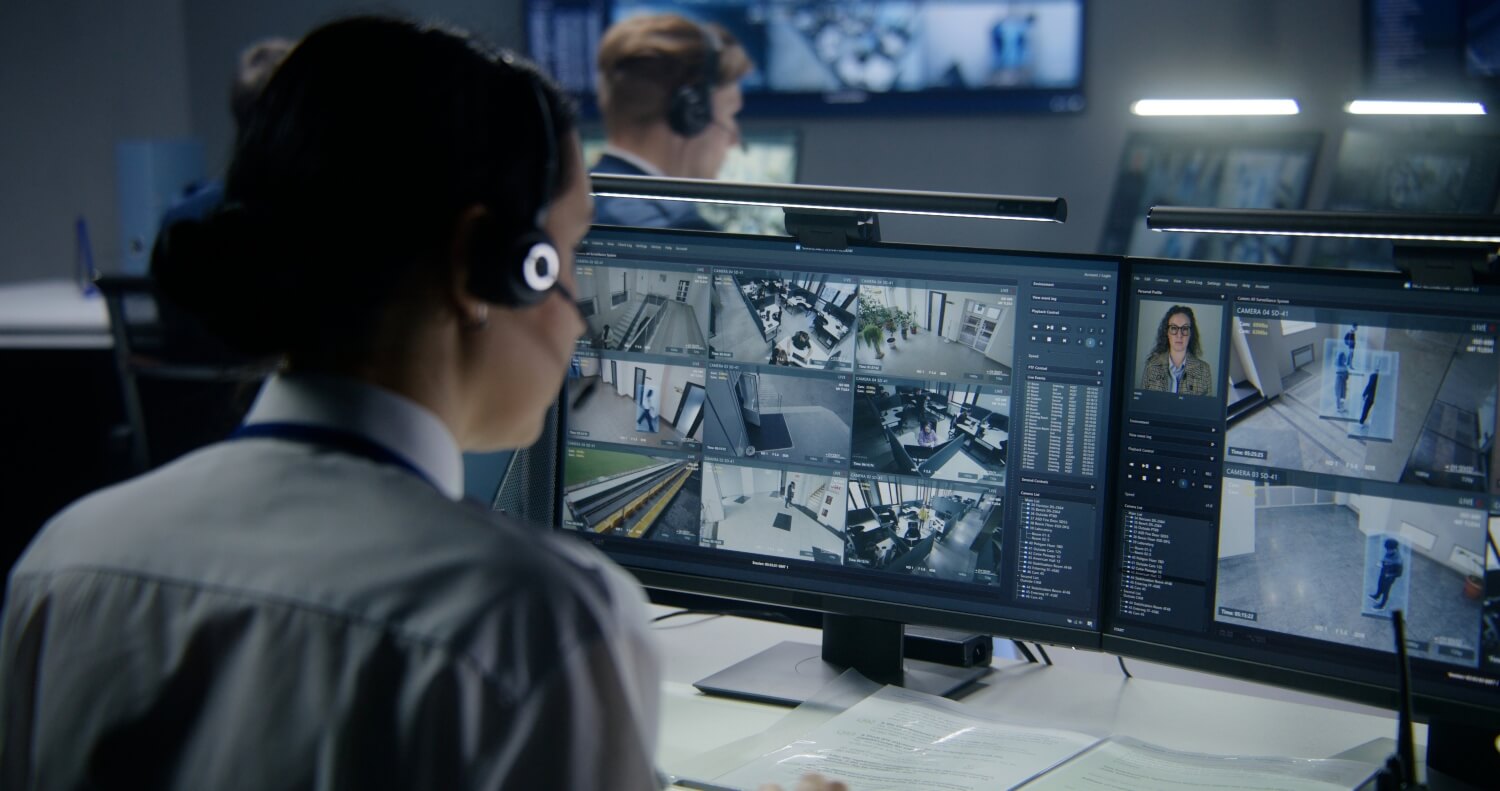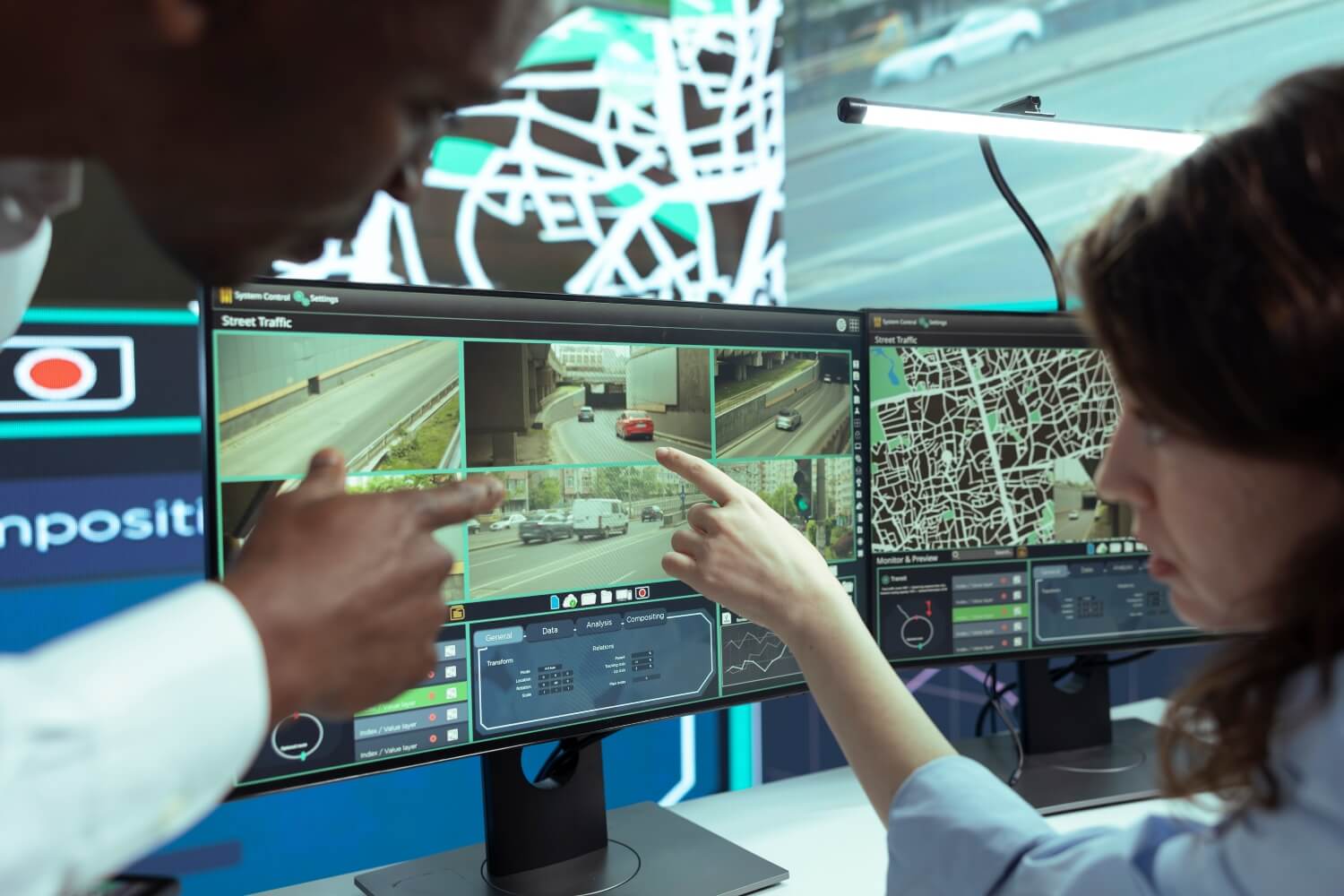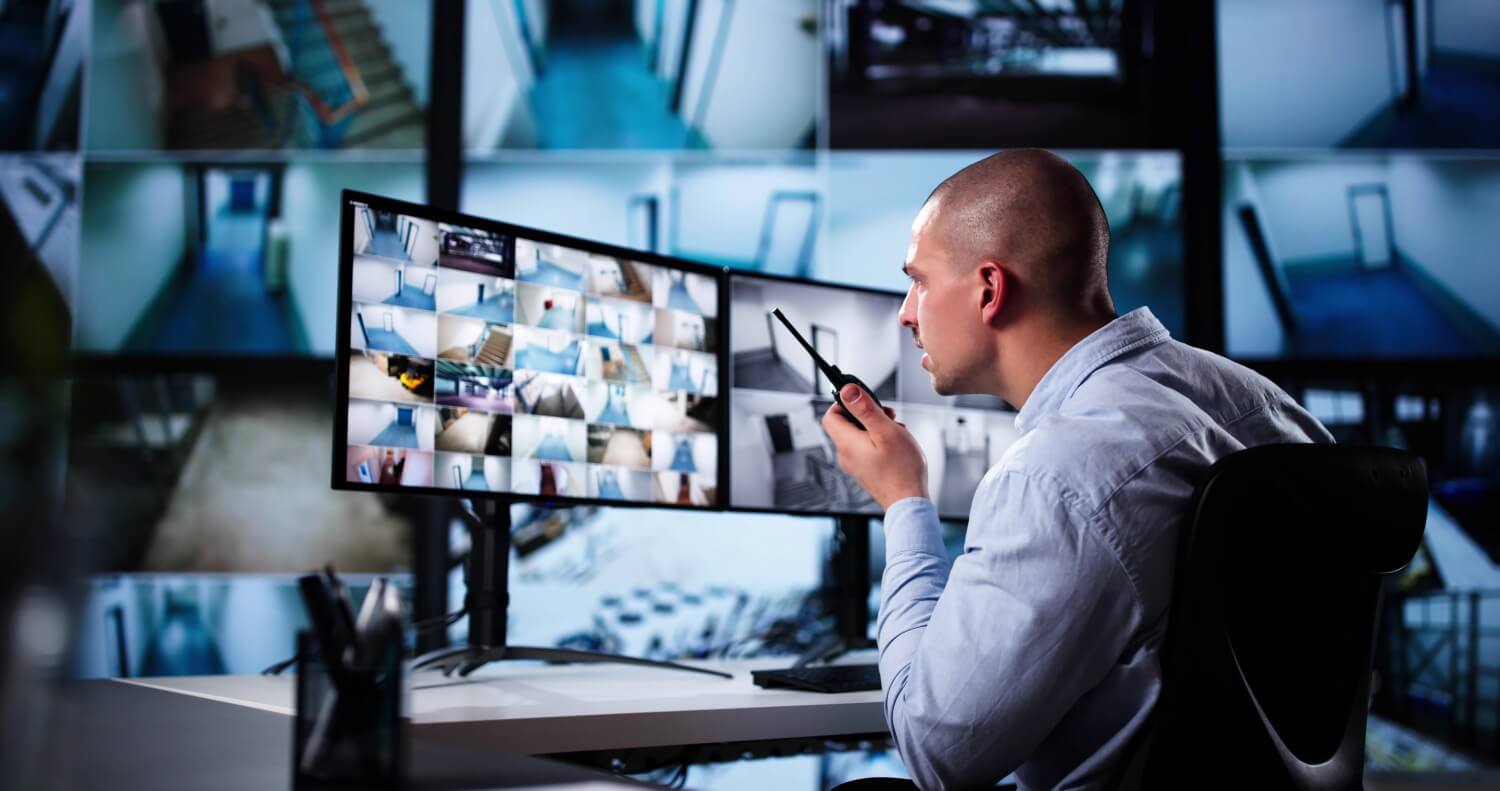According to a systematic review of CCTV evaluations, coordinated camera programs are associated with an overall ~13% reduction in crime across settings, reinforcing the value of organized, real-time monitoring rather than stand-alone cameras.
At Pioneer Security, we believe that oversight, prevention, and clear situational awareness are the pillars of smart protection. Surveillance control rooms centralize security operations, connect live data streams, and empower operators to act quickly and decisively. This article explores how control rooms improve security, drawing on the latest industry best practices and the proven methods we use with our clients.
What Makes a Control Room the Nerve Center
If you want to know where security decisions are made and action truly happens, you have to look inside the control room.
Defining the Heart of Security Operations
A surveillance control room is more than a bank of monitors; it is the nerve center of security management. This is where CCTV systems, alarm panels, access control feeds, and incident management dashboards converge. All the information critical to your property’s safety comes together in a single, secure space, giving operators a real-time snapshot of everything that matters.
This is even backed by standards such as ISO 11064, which defines ergonomic principles and workstation requirements for control centres. At the same time, UL 827 sets performance expectations for certified central‑station alarm services, both codifying how a professionally run control room should function.
Inside a control room, operators oversee multiple monitoring stations, each one feeding live data into an integrated dashboard. The result is a command and control hub where every alert, every camera feed, and every sensor reading can be reviewed and acted upon instantly.
The Role of the Security Operator
Operators in the control room are highly trained. They do more than watch screens. They interpret feeds, coordinate responses, escalate incidents, and make judgment calls under pressure. Their actions are the first and most important line of defense, often preventing minor issues from becoming major breaches.
According to research, vigilance tasks are mentally demanding and performance declines over time, which means designs and procedures must actively support operator attention and situational awareness.
How Data Streams Drive Security
Modern control rooms centralize not just video but also data from access control systems, visitor logs, and even environmental sensors. This gives security teams comprehensive oversight, they know who’s coming and going, where alarms are triggered, and how incidents are developing. With every element connected, nothing slips through the cracks.
Guidance such as ISO 22320 (Emergency management, Guidelines for incident management) emphasizes unified command, clear roles, and structured information flows, exactly the kind of orchestration a control room delivers.
What is the primary function of a surveillance control room?
A surveillance control room serves as the central point for all security monitoring, data collection, and incident management. It unifies video, alarms, and access control into one coordinated command hub, ensuring nothing is overlooked.
Unified Security Through Integrated Systems
Integration is the secret ingredient that turns individual tools into a powerful, unified security force.
Bringing Systems Together for Cohesive Protection
Gone are the days when security teams had to juggle separate systems that didn’t communicate. Today’s integrated security control rooms bring together cameras, alarms, building access, and even HVAC and emergency systems. This integration creates a consolidated view that’s far greater than the sum of its parts.
The Power of Integration
With all systems linked into a unified dashboard, operators gain holistic situational awareness. They can monitor video surveillance alongside intrusion detection, fire alarms, IoT devices, and building controls. This synergy ensures faster, more coordinated responses when seconds matter.
For video systems specifically, IEC 62676‑2‑11 (2024) defines interoperability profiles for VMS and cloud VSaaS, facilitating cross‑system actions and remote support during critical incidents.
Interoperability in Action
Imagine an access control event, a door is forced open in a restricted area. Instantly, the system triggers a camera to focus on the location, logs the incident, notifies the operator, and even signals HVAC systems to shut airflow to that zone if needed. Integration transforms individual systems into a single, agile security machine.
In fact, smoke-control requirements reinforce this as the NFPA 92 requires use of UL 864 (UUKL)- listed control equipment, ensuring standardized interfaces when HVAC responds to fire or smoke events.
Key Security Systems Integrated in a Modern Control Room
| System Type | Function | Control Room Benefit |
| Video Surveillance | Real-time monitoring | Visual verification and incident evidence |
| Intrusion Detection | Detects unauthorized access | Triggers immediate alerts |
| Fire Alarms | Senses smoke/heat | Coordinates safe evacuation, rapid alerts |
| Access Control | Manages entry/exit points | Restricts, tracks, and logs access |
| Building Automation | Controls HVAC, lighting, and elevators | Supports emergency protocols |
| IoT Devices | Sensors for motion, air quality, etc | Adds additional data streams |
How do integrated systems improve security control room efficiency?
Integrated systems eliminate blind spots and communication gaps, letting operators handle every aspect of security from a single dashboard. This speeds up response times and ensures all incidents are managed cohesively.
Real-Time Monitoring Drives Smarter Response
The true advantage of a surveillance control room lies in its ability to deliver complete oversight the moment it’s needed most, ensuring your entire property is always under a watchful eye. This is how surveillance control rooms improve security, shifting from reactive to truly proactive protection.
- Continuous Oversight Prevents Escalation: Real-time monitoring is at the core of proactive security. Instead of passively recording video, operators are actively watching for anything out of the ordinary. This vigilance means suspicious activity is caught the moment it happens, allowing for a swift response that can stop incidents from escalating into serious problems.
- Immediate Response to Live Alerts: Every time the control room receives an alert, whether triggered by a motion sensor, access control breach, or a manual panic button, operators are ready to act. They have instant access to live video, detailed floor plans, and direct communication channels with both on-site staff and emergency responders. This rapid situational assessment enables quick decision-making.
- Rapid Coordination Across Teams: When an incident occurs, operators don’t work alone. They coordinate seamlessly with security personnel, building management, and first responders, ensuring everyone gets the correct information at the right time. The control room acts as a central hub for all communications, eliminating confusion and reducing response times.
- Comprehensive Incident Tracking: Leading control rooms rely on robust incident management platforms. Every event is logged and tracked from the initial alert through to resolution. This process ensures all actions are documented, keeps team members accountable, and prevents anything from falling through the cracks.
How does real-time monitoring help in preventing incidents?
Real-time monitoring gives operators the ability to spot threats as they develop and intervene before issues escalate, reducing both risk and potential loss.
AI and Analytics: Smarter Detection, Better Value
Today’s control rooms are getting smarter, and it’s all thanks to advances in artificial intelligence and analytics.
The Shift Toward Intelligent Security
Artificial intelligence and video analytics have raised the bar for surveillance control rooms. Smart systems now flag unusual behavior, recognize faces, and even predict patterns that signal a developing risk. This automation means fewer false alarms and more focused operator attention.
Peer-reviewed studies demonstrate that deep-learning approaches can improve detection precision and reduce false-positive alarms in surveillance tasks, helping operators focus on genuine events.
How AI Reduces False Alarms
Traditional systems can overwhelm teams with alerts that turn out to be harmless, such as moving shadows, animals, or weather changes. AI-powered analytics filter out these “noise” events by recognizing what’s normal and what’s not. Operators see only genuine threats, boosting efficiency and reducing fatigue.
As a matter of fact, reducing nuisance alerts matters because research and government summaries indicate that 90–99% of police alarm activations are false in many jurisdictions, wasting millions of dollars and significant officer time.
Predictive Analysis for Proactive Security
With advanced analytics, control rooms can identify risk factors before incidents occur. For instance, AI might flag a vehicle circling a parking lot at odd hours or detect people loitering near restricted areas. This kind of predictive insight allows for truly proactive security management.
What are the benefits of using AI in surveillance control rooms?
AI improves detection accuracy, reduces unnecessary alerts, and allows operators to focus on genuine risks. Over time, this not only strengthens security but also delivers significant cost savings. Recent peer‑reviewed work shows that more intelligent filtering of false positives makes video analysis more effective and reliable in practice.
Operator Performance: Design that Supports Focus
Technology is only as effective as the people operating it, and their environment makes all the difference.
The Human Element of Security
Even the smartest technology needs skilled operators at the helm. Control room design has a significant impact on operator alertness, focus, and performance. At Pioneer Security, we know that the environment matters.
Ergonomics and Comfort
From adjustable seating to proper lighting, every detail of the workspace affects how long operators can maintain their concentration. Workstations should minimize glare and eye strain, while acoustic control reduces noise distractions. This is supported by ISO 11064 (Ergonomic design of control centres), which lays out workstation and layout requirements to support sustained, high‑reliability monitoring.
Layouts that Encourage Efficiency
Screens and dashboards are arranged to maximize visibility and workflow efficiency. Critical feeds are placed front and center, while less urgent data is off to the side. This setup keeps operators engaged, responsive, and ready to act.
Why is ergonomic design important in surveillance control rooms?
Ergonomic design helps operators stay alert and comfortable, reducing fatigue and errors. This ensures the highest level of performance during long shifts.
Resilience: Keeping Eyes on the Ground 24/7
Criminals and emergencies don’t wait for convenient times, so your control room must be vigilant day and night.
Uninterrupted Security Operations
Reliability is everything when it comes to security. Control rooms must be equipped to handle power outages, network failures, and natural disasters. With the right infrastructure, organizations can keep their eyes on the ground no matter what. Consistent vigilance means threats are detected and addressed without delay, even in challenging conditions. This level of readiness is essential for protecting both people and property at all times.
Redundant Systems and Backup Power
Best-in-class control rooms include redundant network connections, backup servers, and uninterruptible power supplies (UPS). These systems keep operations running smoothly through equipment failures or utility disruptions. With built-in redundancy, there is always a backup ready to take over if the primary system falters, eliminating critical downtime. This ensures continuous monitoring and rapid response, even during storms or unexpected outages. Ultimately, these safeguards provide the peace of mind that comes from knowing your security never takes a break.
Disaster Recovery and Business Continuity
Comprehensive disaster recovery plans and regular drills ensure that operators are prepared for any scenario. By practicing these protocols, control rooms maintain business continuity even under pressure. Training exercises help teams react swiftly and confidently during emergencies, minimizing confusion and potential losses. Well-developed recovery strategies mean your organization can quickly restore security operations after a significant event. This commitment to preparedness keeps your facility protected, no matter what challenges arise.
How do control rooms maintain 24/7 operations during outages or disasters?
Through redundant systems, backup power, and tested disaster recovery protocols, control rooms can continue to monitor and respond to security threats even during emergencies.
Layered Protection for the Control Room Itself
Protecting the control room is just as critical as protecting the property it monitors. If someone were to compromise your control room, physically or digitally, it could undermine your entire security strategy. That’s why the best surveillance control rooms are secured using a layered approach, where physical security, procedural safeguards, and cybersecurity protocols all work together to create a truly robust defense.
Access Control and Physical Safeguards
Entry to the control room is tightly controlled with secure credentials, biometric scans, and audit logs of every access event. Only authorized personnel, those who have been vetted and trained, can step inside. This extends beyond just locking the door. Facilities often employ reinforced walls, security doors, shatterproof windows, and even duress alarms to protect the control room from forced entry or tampering.
This layered approach maps directly to control families in NIST SP 800‑53 Rev. 5, including Physical & Environmental Protection (PE) and Access Control (AC).
Physical barriers such as security vestibules, keycard access, and surveillance coverage of entry points further reduce the risk of unauthorized access. Some organizations use two-factor authentication and mantrap vestibules, where entry requires passing through two interlocked doors, allowing verification at each step. Strict visitor management policies ensure that all guests are escorted and logged, leaving a complete audit trail of every entry and exit.
Procedural Safeguards and Operator Training
Adequate protection is not just about technology, it’s about people and procedures. Operators and supervisors are regularly trained in emergency protocols, threat recognition, and privacy compliance. Regular drills, role-based access assignments, and clear chain-of-command procedures keep the team alert and ready to act if a threat emerges. Sensitive areas within the control room, such as server racks or data terminals, may be compartmentalized to restrict access even among staff.
Cybersecurity and Data Privacy
Data in the control room is protected by encryption, firewalls, and compliance with industry standards such as SOC 2, HIPAA, or CJIS, depending on your facility’s needs. All network traffic in and out of the control room is monitored for unusual activity. Multi-layered firewalls, intrusion detection systems, and endpoint protection guard against cyber threats.
These frameworks are codified by AICPA’s SOC 2 Trust Services Criteria, HHS’s HIPAA Security Rule, and the FBI’s CJIS Security Policy, each with explicit requirements for security, availability, and protected data handling.
Operators use secure workstations, strong passwords, and multi-factor authentication for all system access. Regular audits and strict policies prevent insider threats, while continuous monitoring quickly detects and responds to suspicious activity. Data backups are encrypted and stored securely to ensure rapid recovery in case of a breach. Every action taken within the control room, whether viewing footage or exporting logs, is tracked and logged for accountability.
Compliance and Continuous Improvement
Pioneer Security partners with organizations to help meet or exceed all regulatory requirements. Our teams review, test, and update control room security policies to address new threats as they arise, ensuring your control room remains ahead of the curve.
How are surveillance control rooms themselves secured?
By combining robust access controls, continuous monitoring, encryption, and compliance measures, control rooms remain secure against both physical and cyber threats.
Smarter Security Starts with Centralized Oversight
Security is never a set-and-forget solution. It’s an ongoing commitment to protecting people, property, and reputation. Surveillance control rooms put your organization in control, offering the real-time oversight, proactive prevention, and operational efficiency you need to stay ahead of threats.
At Pioneer Security, we know that the right blend of technology, human expertise, and responsive service is the foundation of reliable protection. By centralizing your security operations in a control room built for the future, you are investing in a safer, more resilient organization. If you’re ready to take your security to the next level, Pioneer Security is here to help you build and maintain a control room that delivers peace of mind every day.
Frequently Asked Questions
What is the difference between live monitoring and traditional CCTV?
Live monitoring means real-time oversight, with operators actively reviewing feeds and responding to alerts. Traditional CCTV systems often only record footage for later review, which can delay response to incidents.
How does a control room support emergency response?
Control rooms enable fast communication with on-site personnel and emergency services. Operators can share live video, direct responders to incident locations, and provide continuous updates.
What should I look for in a control room service provider?
Look for a provider with experience in system integration, operator training, and responsive support. Ensure they prioritize both physical and cyber security, offering scalable solutions.
Are control rooms suitable for small businesses?
Yes. Modern control rooms can be tailored for organizations of any size, providing scalable security solutions that grow with your needs.






